Are your web browser’s new tab, startpage and search provider overridden and when you try to open your homepage, you’re automatically redirected to the Private Web Search? Then it is a sign that your personal computer has become a victim of the PUP (potentially unwanted program) from the browser hijacker category. It is a type of malware that is developed to change certain settings of installed browsers. To remove the hijacker you need to clean your web browser from any add-ons you have recently installed on your PC and perform a scan using a trustworthy anti malware or antivirus program.
Besides the fact that Private Web Search hijacker modifies your start page, this undesired web-page can set yourself as your search provider. But, obviously, it does not give you a good search results, as they will consist of lots of advertisements, links to undesired and ad sites and only the remaining part is search results for your query from the major search engines. Of course, the very fact that you encounter with the inability to properly search the World Wide Web, is an unpleasant moment. Moreover, the Private Web Search hijacker can collect lots of marketing-type data about you. This confidential information, in the future, may be used for marketing purposes. What creates the risk of theft of user data.
It is probably that you might be worried with the hijacker which reroutes your web browser to intrusive Private Web Search webpage. You should not disregard this undesired software. The hijacker might not only modify your homepage or search provider, but redirect your web-browser to misleading web-sites. What is more, the hijacker can analyze your browsing, and gain access to your confidential information and, later, can use it for marketing purposes. Thus, there are more than enough reasons to remove Private Web Search from your web-browser.
Most often, the Private Web Search hijacker affects most common web browsers such as Mozilla Firefox, Chrome, Internet Explorer and MS Edge. But such hijacker infections as well can infect other web-browsers by modifying its shortcuts (adding ‘http://site.address’ into Target field of web-browser’s shortcut). So every time you start the browser, it’ll open the Private Web Search. Even if you setup your start page again, the intrusive Private Web Search web site will be the first thing which you see when you launch the browser.
Thus, it’s clear that the presence of browser hijacker infection on your personal computer is not desirable, and you need to clean up your PC without a wait. Follow the few simple steps below in order to get rid of Private Web Search from Mozilla Firefox, MS Edge, Chrome and IE.
Remove Private Web Search from Chrome, Firefox, IE, Edge
As with uninstalling ad supported software, malicious software or potentially unwanted apps, there are few steps you can do. We recommend trying them all. If you do only one part of the guidance, then it should be run malicious software removal utility, because it should get rid of hijacker and stop any further infection. But to completely remove the Private Web Search you’ll have to at least reset your browser settings such as startpage, default search engine and new tab to default state, disinfect web browsers shortcuts, remove all unwanted and suspicious software, and get rid of browser hijacker with malware removal tools. Some of the steps below will require you to exit this web-page. So, please read the guidance carefully, after that bookmark or print it for later reference.
To remove Private Web Search, complete the following steps:
- How to remove Private Web Search manually
- How to get rid of Private Web Search with free software
- Use AdBlocker to stop Private Web Search
- How to Private Web Search get installed onto computer
- Finish words
How to remove Private Web Search manually
Most common hijackers may be removed without any antivirus apps. The manual browser hijacker removal is step-by-step instructions that will teach you how to remove the Private Web Search .
Delete dubious software using MS Windows Control Panel
Check out the Windows Control Panel (Programs and Features section) to see all installed applications. We recommend to click on the “Date Installed” in order to sort the list of software by the date you installed them. If you see any unknown and suspicious programs, they are the ones you need to uninstall.
Windows 10, 8.1, 8
Click the Microsoft Windows logo, and then press Search ![]() . Type ‘Control panel’and press Enter as displayed in the figure below.
. Type ‘Control panel’and press Enter as displayed in the figure below.

After the ‘Control Panel’ opens, press the ‘Uninstall a program’ link under Programs category as displayed on the image below.

Windows 7, Vista, XP
Open Start menu and choose the ‘Control Panel’ at right as displayed in the following example.

Then go to ‘Add/Remove Programs’ or ‘Uninstall a program’ (Microsoft Windows 7 or Vista) as on the image below.

Carefully browse through the list of installed software and remove all questionable and unknown programs. We suggest to click ‘Installed programs’ and even sorts all installed applications by date. When you have found anything suspicious that may be the browser hijacker which alters internet browser settings to replace your home page, search provider and newtab with Private Web Search page or other PUP (potentially unwanted program), then select this program and click ‘Uninstall’ in the upper part of the window. If the questionable program blocked from removal, then run Revo Uninstaller Freeware to completely remove it from your personal computer.
Disinfect the internet browser’s shortcuts to remove Private Web Search
When installed, the hijacker responsible for redirecting user searches to Private Web Search, may add an argument like “http://site.address” into the Target property of the desktop shortcut file for the Microsoft Internet Explorer, Mozilla Firefox, Microsoft Edge and Google Chrome. Due to this, every time you run the web-browser, it will display an intrusive website.
Right click on the shortcut file of affected web browser as displayed on the screen below.
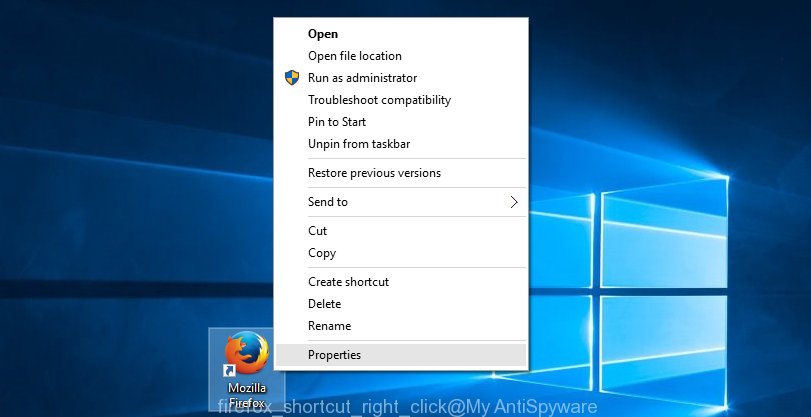
Select the “Properties” option and it will display the shortcut file’s properties. Next, click the “Shortcut” tab and then delete the “http://site.address” string from Target field as displayed in the following example.
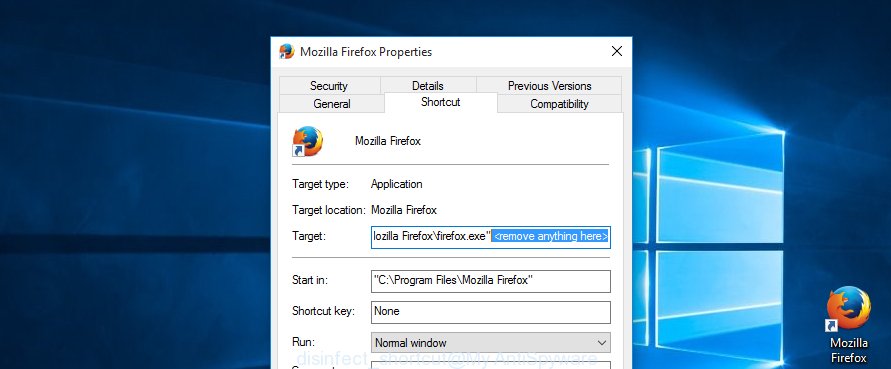
Then click OK to save changes. Repeat the step for all browsers that are re-directed to the unwanted Private Web Search.
Get rid of Private Web Search from Internet Explorer
If you find that IE web browser settings like search provider, new tab page and home page had been hijacked, then you may revert back your settings, via the reset browser procedure.
First, run the Microsoft Internet Explorer, then click ‘gear’ icon ![]() . It will show the Tools drop-down menu on the right part of the browser, then click the “Internet Options” as shown in the figure below.
. It will show the Tools drop-down menu on the right part of the browser, then click the “Internet Options” as shown in the figure below.

In the “Internet Options” screen, select the “Advanced” tab, then click the “Reset” button. The IE will open the “Reset Internet Explorer settings” dialog box. Further, click the “Delete personal settings” check box to select it. Next, click the “Reset” button as shown on the screen below.

When the procedure is finished, click “Close” button. Close the Microsoft Internet Explorer and reboot your machine for the changes to take effect. This step will help you to restore your web browser’s start page, default search provider and new tab page to default state.
Remove Private Web Search from Chrome
Use the Reset web-browser tool of the Chrome to reset all its settings such as search engine by default, homepage and newtab page to original defaults. This is a very useful tool to use, in the case of browser hijacks like Private Web Search.

- First, start the Google Chrome and click the Menu icon (icon in the form of three dots).
- It will show the Google Chrome main menu. Select More Tools, then click Extensions.
- You will see the list of installed extensions. If the list has the addon labeled with “Installed by enterprise policy” or “Installed by your administrator”, then complete the following steps: Remove Chrome extensions installed by enterprise policy.
- Now open the Chrome menu once again, click the “Settings” menu.
- Next, click “Advanced” link, which located at the bottom of the Settings page.
- On the bottom of the “Advanced settings” page, press the “Reset settings to their original defaults” button.
- The Chrome will show the reset settings dialog box as shown on the image above.
- Confirm the browser’s reset by clicking on the “Reset” button.
- To learn more, read the article How to reset Chrome settings to default.
Delete Private Web Search redirect from Mozilla Firefox
Resetting Mozilla Firefox internet browser will reset all the settings to their original state and will remove Private Web Search, malicious add-ons and extensions. However, your themes, bookmarks, history, passwords, and web form auto-fill information will not be deleted.
First, start the Firefox. Next, click the button in the form of three horizontal stripes (![]() ). It will display the drop-down menu. Next, click the Help button (
). It will display the drop-down menu. Next, click the Help button (![]() ).
).

In the Help menu press the “Troubleshooting Information”. In the upper-right corner of the “Troubleshooting Information” page press on “Refresh Firefox” button like below.

Confirm your action, click the “Refresh Firefox”.
How to get rid of Private Web Search with free software
If you’re an unskilled computer user, then we suggest to run free removal tools listed below to delete Private Web Search home page for good. The automatic solution is highly recommended. It has less steps and easier to implement than the manual method. Moreover, it lower risk of system damage. So, the automatic Private Web Search removal is a better option.
Run Zemana Anti Malware (ZAM) to get rid of hijacker
You can delete Private Web Search redirect automatically with a help of Zemana. We suggest this malware removal tool because it can easily delete hijackers, potentially unwanted software, adware and toolbars with all their components such as folders, files and registry entries.
Click the following link to download the latest version of Zemana Anti-Malware (ZAM) for MS Windows. Save it to your Desktop.
164814 downloads
Author: Zemana Ltd
Category: Security tools
Update: July 16, 2019
When the downloading process is complete, close all applications and windows on your personal computer. Open a directory in which you saved it. Double-click on the icon that’s named Zemana.AntiMalware.Setup like below.
![]()
When the setup starts, you will see the “Setup wizard” that will allow you install Zemana on your machine.

Once installation is finished, you will see window like below.

Now click the “Scan” button to look for hijacker that alters web-browser settings to replace your new tab, home page and default search engine with Private Web Search web site. This task can take quite a while, so please be patient. When a threat is detected, the number of the security threats will change accordingly.

After the system scan is done, you’ll be displayed the list of all found items on your PC system. When you’re ready, press “Next” button.

The Zemana Anti-Malware (ZAM) will remove hijacker responsible for redirecting your browser to Private Web Search web site and move threats to the program’s quarantine.
Use HitmanPro to get rid of Private Web Search from the personal computer
HitmanPro is a portable utility which scans for and uninstalls undesired apps like browser hijackers, ad-supported software, toolbars, other web-browser extensions and other malware. It scans your PC for hijacker infection related to Private Web Search startpage and creates a list of threats marked for removal. HitmanPro will only erase those unwanted programs that you wish to be removed.
Hitman Pro can be downloaded from the following link. Save it on your Windows desktop.
Download and use HitmanPro on your system. Once started, click “Next” button to start scanning your computer for the hijacker responsible for redirects to Private Web Search. A system scan can take anywhere from 5 to 30 minutes, depending on your PC. While the Hitman Pro is checking, you can see count of objects it has identified either as being malicious software..
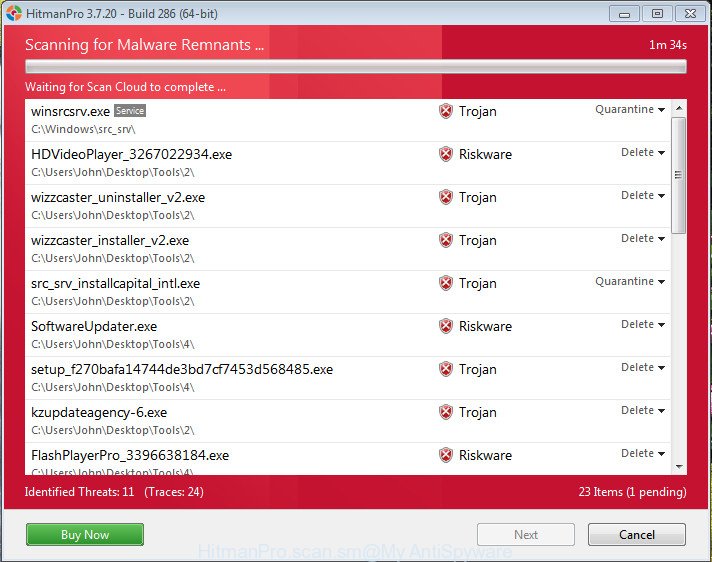
As the scanning ends, Hitman Pro will produce a list of unwanted programs ad-supported software.
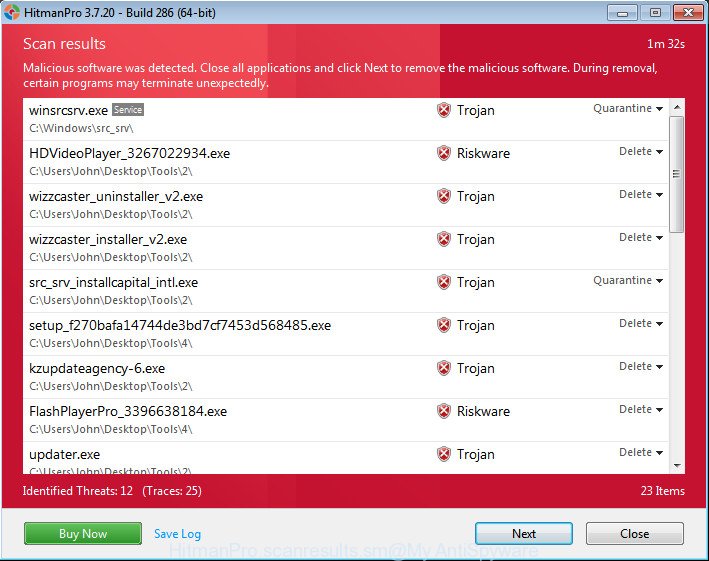
Review the scan results and then click Next button.
It will open a prompt, click the “Activate free license” button to start the free 30 days trial to delete all malware found.
How to automatically get rid of Private Web Search with Malwarebytes
We suggest using the Malwarebytes Free. You may download and install Malwarebytes to detect and delete Private Web Search homepage from your personal computer. When installed and updated, the free malware remover will automatically scan and detect all threats present on the personal computer.
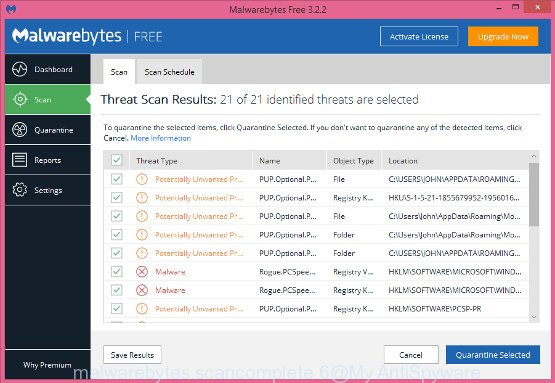
- MalwareBytes AntiMalware (MBAM) can be downloaded from the following link. Save it to your Desktop so that you can access the file easily.
Malwarebytes Anti-malware
327071 downloads
Author: Malwarebytes
Category: Security tools
Update: April 15, 2020
- Once the download is finished, close all applications and windows on your PC system. Open a file location. Double-click on the icon that’s named mb3-setup.
- Further, click Next button and follow the prompts.
- Once installation is complete, press the “Scan Now” button . MalwareBytes utility will start scanning the whole PC system to find out hijacker which reroutes your web-browser to undesired Private Web Search page. A system scan may take anywhere from 5 to 30 minutes, depending on your computer. While the MalwareBytes Free is scanning, you can see number of objects it has identified either as being malware.
- Once MalwareBytes Anti-Malware completes the scan, MalwareBytes Anti-Malware will show a screen which contains a list of malware that has been found. When you are ready, click “Quarantine Selected”. Once the cleaning procedure is finished, you may be prompted to reboot your PC.
The following video offers a step-by-step guidance on how to delete hijackers, adware and other malware with MalwareBytes Anti Malware.
Use AdBlocker to stop Private Web Search
If you want to delete annoying advertisements, web browser redirects and pop ups, then install an ad blocking program such as AdGuard. It can block Private Web Search, ads, pop ups and stop sites from tracking your online activities when using the Microsoft Internet Explorer, MS Edge, Firefox and Chrome. So, if you like surf the Internet, but you do not like annoying ads and want to protect your computer from harmful webpages, then the AdGuard is your best choice.
Download AdGuard on your Microsoft Windows Desktop from the link below.
26843 downloads
Version: 6.4
Author: © Adguard
Category: Security tools
Update: November 15, 2018
After the download is finished, start the downloaded file. You will see the “Setup Wizard” screen as shown in the following example.

Follow the prompts. Once the installation is done, you will see a window as displayed in the following example.

You can click “Skip” to close the installation program and use the default settings, or click “Get Started” button to see an quick tutorial which will allow you get to know AdGuard better.
In most cases, the default settings are enough and you don’t need to change anything. Each time, when you start your machine, AdGuard will launch automatically and stop pop-up advertisements, Private Web Search redirect, as well as other malicious or misleading web sites. For an overview of all the features of the program, or to change its settings you can simply double-click on the AdGuard icon, which is located on your desktop.
How to Private Web Search get installed onto computer
The Private Web Search browser hijacker come as a part of various freeware. This means that you need to be very careful when installing applications downloaded from the Internet, even from a large proven hosting. Be sure to read the Terms of Use and the Software license, choose only the Manual, Advanced or Custom installation type, switch off all additional modules and software are offered to install.
Finish words
Once you’ve complete the step-by-step tutorial outlined above, your machine should be clean from this browser hijacker and other malware. The IE, Firefox, Chrome and Edge will no longer show annoying Private Web Search web-site on startup. Unfortunately, if the step-by-step guide does not help you, then you have caught a new browser hijacker infection, and then the best way – ask for help.
Please create a new question by using the “Ask Question” button in the Questions and Answers. Try to give us some details about your problems, so we can try to help you more accurately. Wait for one of our trained “Security Team” or Site Administrator to provide you with knowledgeable assistance tailored to your problem with the intrusive Private Web Search .


















